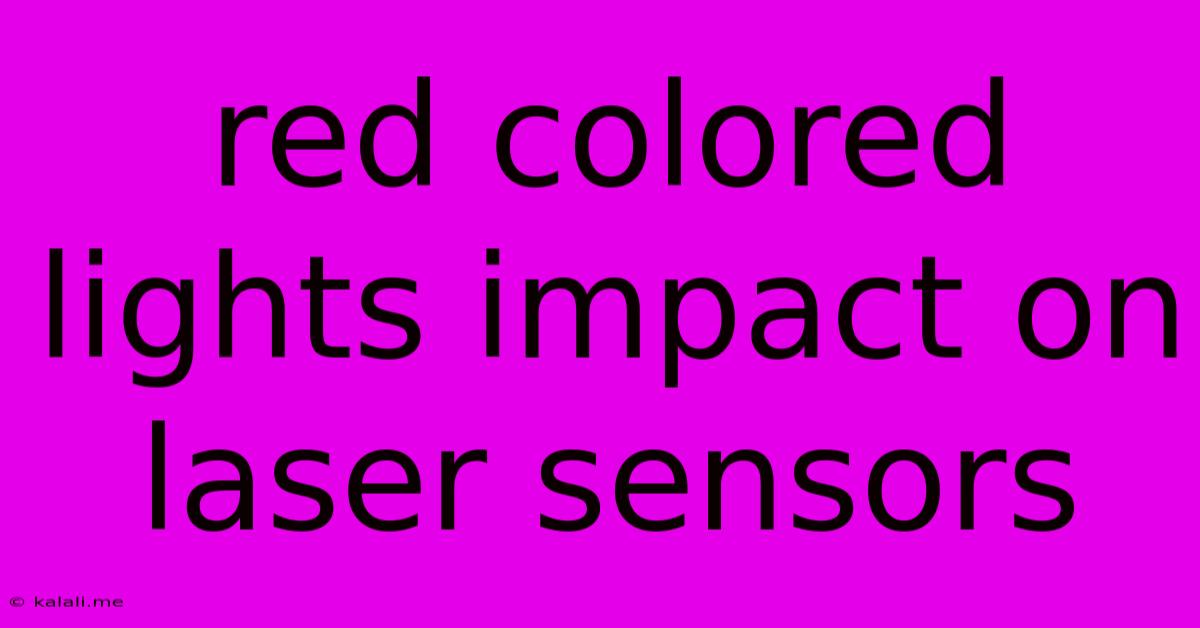Red Colored Lights Impact On Laser Sensors
Kalali
Jun 05, 2025 · 3 min read

Table of Contents
The Impact of Red Light on Laser Sensors: A Comprehensive Guide
Meta Description: Discover how red light affects the performance of laser sensors. This guide explores the interaction between red light wavelengths and various laser sensor types, highlighting potential interference and mitigation strategies. Learn how to optimize your sensor systems for accurate readings in red-light environments.
Laser sensors are ubiquitous in modern technology, used in everything from industrial automation to automotive safety systems. Their accuracy and reliability are paramount, but their performance can be significantly affected by external factors, including ambient light. This article delves into the specific impact of red light on laser sensors, explaining the mechanisms involved and offering strategies for mitigating interference.
Understanding Laser Sensor Operation
Before discussing the effects of red light, it's crucial to understand how laser sensors function. These sensors emit a laser beam that interacts with an object. The reflected light is then analyzed to determine distance, presence, or other properties. The wavelength of the emitted laser beam is critical; common wavelengths include infrared (IR), red, and near-infrared (NIR).
How Red Light Interferes with Laser Sensors
The impact of red light on laser sensor performance depends largely on the wavelength of the laser beam emitted by the sensor itself. Here's a breakdown:
1. Sensors using wavelengths different from red light:
-
Infrared (IR) and Near-Infrared (NIR) Sensors: These sensors are generally less affected by red light. Red light falls outside their primary sensitivity range, minimizing interference. However, extremely intense red light sources could still saturate the sensor's detector, leading to inaccurate readings or complete failure. This is more likely with less sophisticated, lower-cost sensors.
-
Increased Noise: Even if not directly interfering with the signal, intense red light can increase the overall noise level detected by the sensor, reducing the signal-to-noise ratio (SNR) and impacting the accuracy of measurements. This is especially relevant for long-range sensors where the reflected signal is already weak.
2. Sensors using red light wavelengths:
-
Direct Interference: If the sensor utilizes a red laser beam, the presence of ambient red light can significantly interfere with the reflected signal. This is because the sensor cannot reliably differentiate between the emitted and reflected red light, leading to inaccurate distance measurements or false positives. This is a crucial consideration in applications involving red light sources like traffic lights or stage lighting.
-
Saturation: High-intensity red light can saturate the sensor's receiver, preventing accurate readings. The sensor might register a constant signal regardless of the presence or absence of the target object.
Mitigating the Effects of Red Light
Several strategies can minimize the impact of red light on laser sensor performance:
-
Sensor Selection: Choose sensors with wavelengths outside the red light spectrum (IR or NIR) if operating in environments with significant red light. This is often the most effective approach.
-
Filtering: Employ optical filters to block or attenuate red light before it reaches the sensor's receiver. These filters are designed to allow only specific wavelengths to pass through, effectively isolating the sensor's signal from ambient red light.
-
Signal Processing: Implementing advanced signal processing techniques can help separate the sensor's emitted signal from the ambient red light. This usually involves sophisticated algorithms that analyze the received signal and filter out unwanted noise.
-
Sensor Placement and Orientation: Strategically positioning the sensor to minimize direct exposure to red light sources can also reduce interference. Careful orientation can also help to reduce reflections of ambient red light that might reach the sensor.
Conclusion
Red light can significantly impact the accuracy and reliability of laser sensors, depending on the sensor's operating wavelength and the intensity of the ambient red light. Understanding these interactions is crucial for designing and implementing robust sensor systems. By carefully considering sensor selection, filtering, signal processing, and sensor placement, it is possible to minimize interference and ensure reliable performance even in challenging red-light environments. This understanding is crucial for diverse applications across numerous industries.
Latest Posts
Latest Posts
-
Points That Lie On The Same Plane
Jun 06, 2025
-
Energy Budget Equation With Navier Stokes
Jun 06, 2025
-
Did Luke Try To Kill Himself In Empire Strikes Back
Jun 06, 2025
-
Side By Side Fridge Freezer Not Working
Jun 06, 2025
-
How Many Concubines And Wives Did David Have
Jun 06, 2025
Related Post
Thank you for visiting our website which covers about Red Colored Lights Impact On Laser Sensors . We hope the information provided has been useful to you. Feel free to contact us if you have any questions or need further assistance. See you next time and don't miss to bookmark.